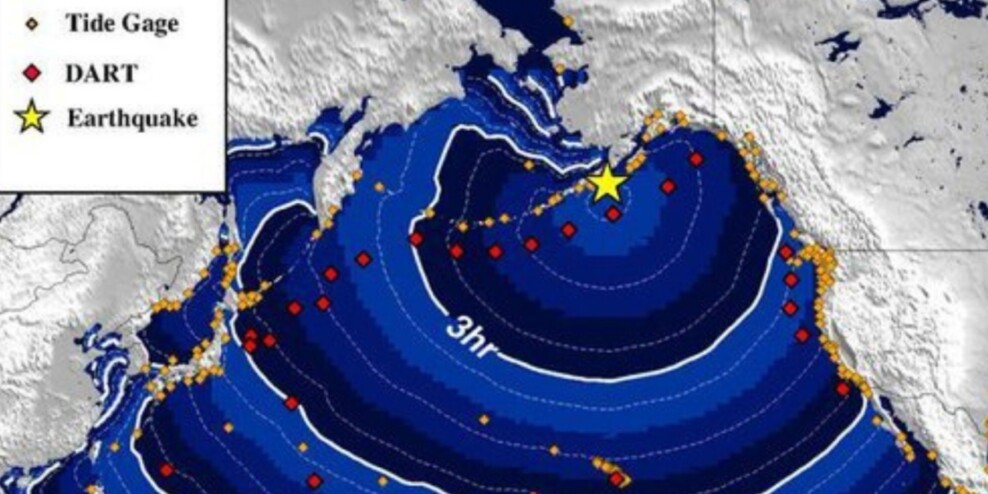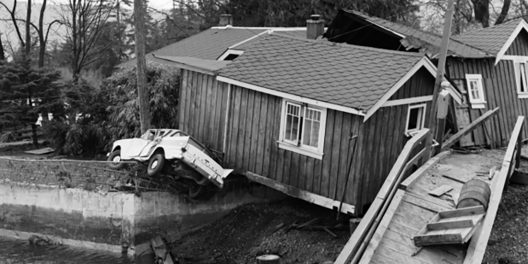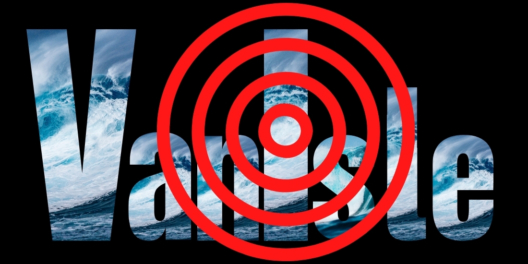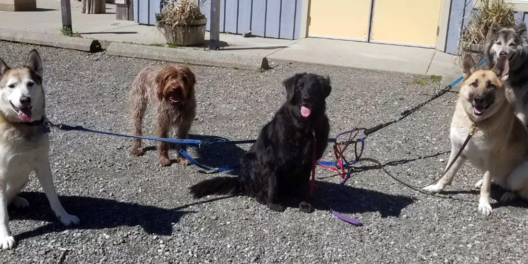Stand by for #BC specific info. https://t.co/VxPpdejlr6
— Emergency Info BC (@EmergencyInfoBC) July 29, 2021
The texts and phone calls started right after the magnitude 8.2 earthquake struck just off Alaska’s southern coast, 91 kilometres east southeast of Perryville, Alaska.
The earthquake is being evaluated; stand by for #BC specific info. https://t.co/bVWLJcMf5q
— Emergency Info BC (@EmergencyInfoBC) July 29, 2021
The US National Tsunami Warning Center, which issues tsunami information for the continental U.S. and Canada, put out a scary map that seemed to show that a tsunami could hit Vancouver Island in about three to four hours.
But three to four hours from when?
It was confusing because Alaska isn’t on Pacific time. Alaska has two time zones: Alaska Time and Hawaii-Aleutian Time, one and two hours behind BC. Different sources said the earthquake happened at different times. Some said 8:15 p.m., others 9:15 p.m., and even others said 10:15 p.m.
Which was correct?
People on Twitter, from Victoria to Haida Gwaii, started scrambling for information from any source. The problem was Emergency Info BC didn’t give out any useful information.
The first update from BC came at 11:32 p.m. Pacific time. Emergency Info BC tweeted the American NWS Tsunami Alerts account and added: “Stand by for #BC specific info.”
People waited and madly surfed the internet to answer simple questions like “Is there a tsunami coming?” “What time will it hit my community or the beaches near loved ones?” “Should I warn my friends and family?”
But there were no answers.
So people stood by.
This earthquake is being evaluated for #BC specific info. After an earthquake, different evaluations are done to produce the most accurate tsunami assessment possible. This data will inform the final threat level for BC. Stand by for more info. https://t.co/p0HxtdGpQ7
— Emergency Info BC (@EmergencyInfoBC) July 29, 2021
A half-hour later, at 11:56 p.m. Pacific time, Emergency Info BC tweeted: “The earthquake is being evaluated; stand by for #BC specific info.”
So people kept waiting.
Coastal folks were left to search frantically for local information about the risk to their homes and loved ones living near the coast.
Then at 12:26 a.m. Pacific time, Emergency Info BC posted a longer warning that still didn’t answer basic questions:
“This earthquake is being evaluated for #BC specific info. After an earthquake, different evaluations are done to produce the most accurate tsunami assessment possible. This data will inform the final threat level for BC. Stand by for more info.”
Thu Jul 29 07:33:22 UTC 2021 event picture pic.twitter.com/c6JL49fzRZ
— NWS Tsunami Alerts (@NWS_NTWC) July 29, 2021
People waited some more. They started getting frantic because the US National Tsunami Warning Center map seemed to show that the tsunami could hit at any minute.
Soon after, the US National Tsunami Warning Center tweeted out the same scary map again.
Islanders again tried to figure out much time they had.
Were we already two or three hours into the countdown?
Was a massive wave about to break nearby or not?
At the same time, a seismologist (earthquake scientist) in Alaska tweeted out a video with the eerie sound of warning sirens.
If you listen to the video carefully, you can hear a loudspeaker telling people to get to high ground.
And now… tsunami warning night mode! Twice the spookiness, double the anxiety. pic.twitter.com/xQSfw4ByyP
— Dr. Kasey Aderhold (@KaseyAderhold) July 29, 2021
TSUNAMI WATCH has been canceled for Hawaii.
— Hawaii Flood Plan (@HawaiiFloodPlan) July 29, 2021
The Hawaiian government cancelled its Tsunami watch at 12:57 p.m. Pacific time.
But then, a few minutes later, at 1:02 a.m. Pacific time, Emergency Info BC continued to tweet that an evaluation is still taking place.
Wait, what?
The earthquake is being evaluated for #BC specific info. The risk assessment process includes confirmed observation of a generated tsunami. After confirmation experts then determine the tsunami threat level and possible wave arrival times. Info will be shared as soon as available https://t.co/Rsd7o5BGCU
— Emergency Info BC (@EmergencyInfoBC) July 29, 2021
If you were awake for this, there was only one question on your mind: should I call my people across coastal BC?
Should I call and wake up friends and family in Sooke, Courtenay, Campbell River, Port Alberni, Cortes, or Piers Islands?
Meanwhile, in Kitamaat Village, south of Kitimat, BC, 800 people scrambled out of bed to get to higher ground just in case.
Skeena MLA Ellis Ross told CBC’s Daybreak North on Thursday morning, “It was not much time to think about anything, really, except getting people to a certain place safely.”
The US National Tsunami Warning Center cancelled warnings early Thursday when the biggest wave, of just over a half foot, was recorded in Old Harbor, Alaska.
Finally, at 2:32 a.m. Pacific time, an hour and a half after the US cancelled its warning, provincial officials confirmed there was no threat to coastal BC. This update came well after the original maps showed the tsunami would have hammered coastal communities.
There is no tsunami threat to #BC as a result of the 8.2M earthquake that was detected earlier this evening southeast of Chignik, Alaska. https://t.co/5XGTRP0hEm
— Emergency Info BC (@EmergencyInfoBC) July 29, 2021
So. What exactly would have happened if there actually had been a tsunami?
Emergency Info BC certainly wouldn’t have had enough time to warn people to get to higher ground.
Islanders were happy a tsunami didn’t hit BC. But many are now venting serious concerns about BC’s emergency system. For example, an #epicfail tweet in response to Emergency Info BC evaluation tweets got lots of likes.
The BC government’s #epicfail on quick tsunami warnings needs to be investigated.
Why are our American neighbours able to get the word out before our government can?
This is concerning by itself. But combined with the government’s sad performance during other recent emergencies, Islanders are left to wonder how protected we really are.
As one concerned citizen wrote on social media, “BC isn’t ready for anything, in any real way. Fires, tsunami’s, daily drug overdoses, COVID mask mandates, heat domes…”
There have been concerns about Emergency Info BC for a long time.
They were criticized back in October 2012 for waiting 50 minutes before issuing a warning about the 7.7 magnitude quake near Haida Gwaii. Before the July 28th quake, it had been the strongest in 60 years on the West Coast.
At the time, then Justice Minister Shirley Bond told Global News, “I think this is a perfect time for us to look at whether we can do a better job.”
Now, at 12:10 a.m., almost 9 years later, she was on Twitter. It was late at night, and again she was raising concerns about the performance of Emergency Info BC.
And yet another potential issue of concern for British Columbians . . . residents anxiously waiting for details about potential tsunami as a result of “significant” earthquake in Alaska – situation is currently being evaluated! https://t.co/Uj9lw4puPx
— Shirley Bond (@shirleybond) July 29, 2021
Unfortunately, it appears that Emergency Info BC‘s performance has gotten worse in the past decade, not better.
But Islanders deserve better.









